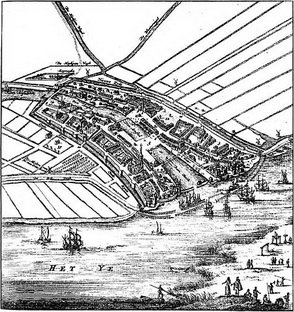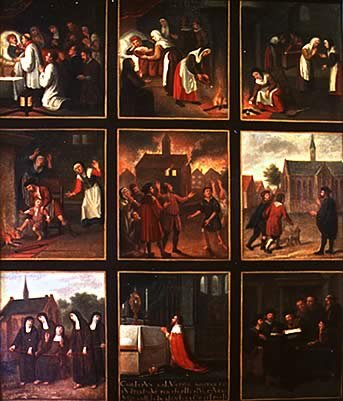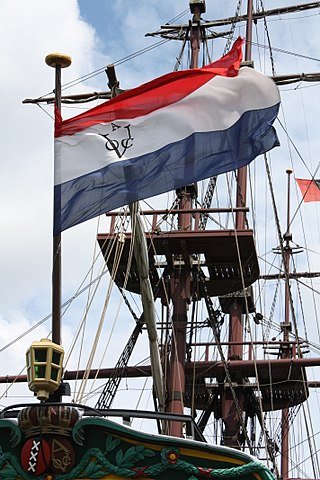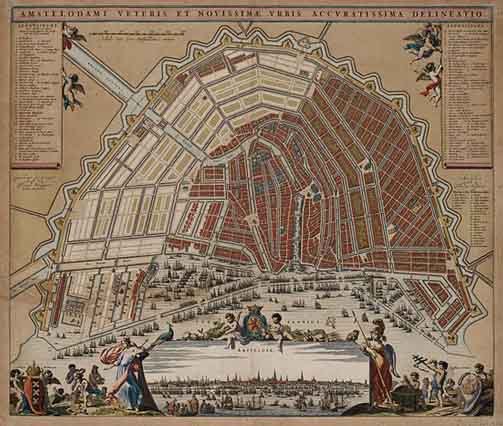T
here is a legend saying that Amsterdam was founded by two fishermen. But the official one states that the city was created in the XIII century when a dam was built on the river. It connected two neighboring settlements, that became one since then. A moment passes before you realize that the name is the explanation – Amster & Dam… a dam on river Amstel.
The very beginnings see the creation of the first, wooden buildings on the west bank (around 1225 AC). Soon the east bank was full of houses too. A water gate joined both around 1250. It allowed creation of a true town square and a bay for the fishing ships.

Agriculture there was almost impossible. The inhabitants of the newly created Amsterdam were fisherman and sailors, soon to become merchants. The patron of the land duke Floris V realized the potential and regulated the road toll allowing everyone to travel without taxes. It was a move that turned the city into a trade hub.
The beginning of the XIV century is the time when the bishop gives Amsterdam the city rights. Everything happens at the same time. The fishermen bring more and more herring, whose growing popularity gives money. Trade with the Baltic cities flourishes.
Why St. Andrew is chosen then to be the patron saint of the city – no one knows today. But three of his crosses (saltire) adorn the coat of arms. They represent the 3 greatest enemies: water, fire, and plague. They lie on a dark line of the river – as Amsterdam does. The crown, lions, and the motto were all added in later times. Each element has its own, intriguing story.
So it was that what gave life to Amsterdam, also invited sickness. But the city proved on each step its survival nature.
The pilgrims started to come here in great numbers in the XIV century. It pushed on the development and all thanks to the Miracle of the Host (happened 13th of March 1345). A dying man who had just received the last rites vomited out an untouched host. They tried to burn it but, miraculously, it survived again and again (on the photo of C. Schenk’s picture – the story). Until today there is a March celebration of this event – a silent procession called Stille Omgang.
Amsterdam was also growing thanks to its sailors and merchants. There were quite a few wealthy Jews that came from Spain and Portugal with their businesses. At the end of the XVI century, first ships sailed to India.
The upcoming years were the best period in the history of Amsterdam. Trade bloomed and the city relived the Hanseatic League’s times of prosperity. The culture also enriched – thanks to the colonies in Suriname and Indonesia. Various spices were brought from there (see the picture).
Amsterdam became the biggest shareholder of the East India Company (VOC). The Dutch rule on the seas began. Soon the spices were that many, that the merchants had to reorganize to continue profiting from the VOC. Plus – they had found something else.
The year 1621 is when the Bears van Berlage Stock Exchange and Amsterdamsche Wesselbank were created. Both were the next step of the evolution of the Holland East India Company. In these times the building of Bears van Berlage was the financial center of Europe; and Amsterdam – one of the richest cities in the world. That wealth partly came from diamonds.
Apart from trade, the other important things that started to happen were religious liberties and freedoms. The inhabitants were purely practical, money was their god and their inventive minds needed some liberties to continue their good business. People come from all over the world. It was a cosmopolitan, liberal city now.
The unity helped to fight the enemy – the watery grounds that could not be built on. The technologies of the XVII century allowed the growth of Amsterdam. More than 200.000 people now lived here – they needed houses. The characteristic layout of canals and tenements was built in a few stages between 1612-1673. It was a wonder of those times – even more since most of the buildings were constructed on wooden stakes.
Tenements were very narrow, but there was money behind it. The taxes were calculated on the width of a house! Not everything was small – the XVI century is the time when the grand town hall is built on the Dam Square. Eventually, it turned into the Palace – what could have made the architect Jacob van Campen very proud. Until today it stands on13659 wooden pillars. It was one of the biggest administrative buildings ever built then.
This Golden Age is a time the Dutch started to grow tulips – the national pride. In the ’30s over 5000 people were working in the industry. For a moment, the flower made everyone crazy (at the photo – the destruction of the fields, painting by Jean-Léon Gérôme). Nevertheless, it is the symbol of the country. Even today over 2 million of these flower buds are exported every year.
Art bloomed like a tulip in these periods. Amsterdam housed great poets and writers – D. C. Hooft or Joost van den Vondel. Or philosophers – Spinoza, Descartes, or John Locke. The most famous in the painting brush department was Rembrandt. Books, painting, jewelry, etc. – these were all luxury products. The city was a center of art, culture, and wealth, there were over 500 libraries and 100 editors (over 30% of the books printed in the world came from Amsterdam).
The next 200 years were hard all over Europe. Wars between England and France were only the tip of everything. The city lost money, power and influence. The French Revolution was next. In 1795 the French armada blocked the port and created a financial disaster for many. Later, they occupied the city and stole much when they were leaving.
The industrial revolution of the XIX century begun the second golden age. But it was short-lived. Two great wars were about to come. On the 10th of May 1940 the German troops invaded Holland. Five days later capitulation documents were signed. Foreigners now ruled the city. Over 100.000 Jews were deported – among them the author of Ann Frank’s diaries. The house where she was hiding for a few years is now a museum (in Jordaan).
After the Wars, the world slowly went back to normal. Amsterdam was regaining its balance. It was now a city of many cultures. The natives were of as much mixed blood as the immigrants. The idea of tolerance and of the acceptance of each other’s differences was growing strong.
Therefore, some subjects and stimulants were no longer a tabu. But this is also why some businesses in De Wallen, were not regulated until the 90’s (The Prostitution Information Point will tell you more).
Today Amsterdam is like a magnet. It has everything that travellers look for – difficult beginnings, dark events, golden years of wealth and prosperity, madness, drugs, legends of De Wallen, strange museums, good food, beautiful views… you just cannot stop listing them all.
Come here yourself and discover it all!

Enjoy sightseeing!









